Indicator scoreboardEMU — April harmonized index of consumer prices (HICP) rose 0.5 percent. When compared with last year, HICP was revised up to 2.4 percent from the originally reported 2.2 percent flash estimate. The core rate of inflation (excluding energy, food, alcohol and tobacco) rose 0.3 percent and 2.4 percent on the year. All subcategories rose except recreation and culture, which fell 0.7 percent. 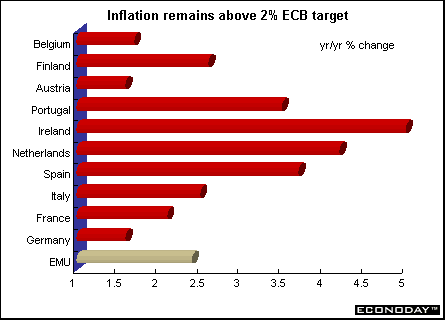 March industrial output rose 0.5 percent due mainly to a strong surge in energy sector production. However, when compared with a year earlier, industrial production was down 2.9 percent. Capital goods production, durable goods production and non-durable goods output were all down. Excluding energy, first quarter industrial output was up 1.0 percent after a 3.8 percent drop in the fourth quarter of 2001. 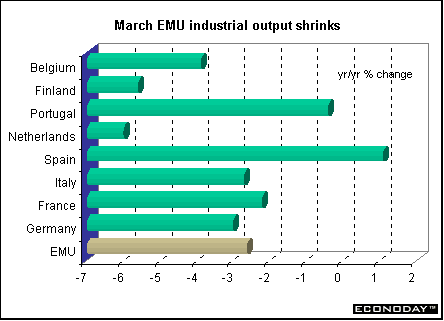 Germany — March seasonally adjusted retail sales (including autos and gasoline) fell 0.5 percent and 4.0 percent when compared with last year. Seasonally and calendar adjusted retail sales excluding auto and petrol station sales declined 4.1 percent on the year. 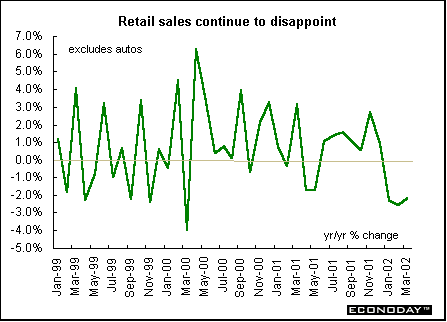 April wholesale prices fell 0.1 percent and 0.5 percent when compared with last year. The data are good news for the ECB, as they suggest that pipeline inflation pressures remain moderate. Seasonal food prices (fresh fruit and vegetables) fell 7.2 percent but rose 1.2 percent on the year. April pan-German final harmonized consumer prices were unchanged but rose 1.6 percent when compared with last year. The national consumer price index rose 0.1 percent and 1.6 percent on the year. Consumer prices excluding heating oil and motor fuels rose 1.6 percent on the year. France — March seasonally and workday adjusted manufacturing output rose 0.2 percent but was 1.5 percent below last year’s level. Autos led the output increases. Semi-finished goods output slowed sharply to an increase of 0.3 percent after jumping 1.6 percent in the previous month, but consumer and capital goods output continued to decline. Overall industry output excluding construction was up 0.5 percent on the month. March seasonally adjusted merchandise trade surplus was €423 million as both exports and imports declined sharply. Exports sank 3 percent, led by drops in the aerospace and naval sectors. Exports in all industry sectors declined except autos. Exports to other European countries and the Middle East fell sharply. Imports also dropped 3 percent led by a decline in autos. Italy — March seasonally and workday adjusted industrial production dropped 0.7 percent after a flat reading in February. On the year, industrial production is down 4.1 percent. Consumer and intermediate goods output fell 0.6 percent and 0.9 percent respectively while investment goods output was unchanged. First quarter preliminary real gross domestic product rose 0.2 percent when compared with the previous quarter and edged up 0.1 percent when compared with last year. This was the lowest year-over-year reading since the first quarter of 1997. No numerical data on the components of first quarter GDP were provided with the release. Britain — April producer output prices rose 0.5 percent and 0.2 percent when compared with last year. This was their largest monthly increase since September 2000, fed by higher petroleum and mineral prices. Most of the latest increase was due to a 2.7 percent monthly change in petroleum product prices. Seasonally adjusted core output prices, which exclude food, tobacco, petroleum and beverages, increased 0.2 percent and by 0.2 percent on the year. Seasonally adjusted input prices rose by 0.9 percent, pushed higher by an 8.3 percent monthly hike in crude oil prices. Input prices fell 3.6 percent on the year.  April claimant count unemployment rose by 5,400. The unemployment rate was 3.2 percent. The unemployment rate remains only slightly above a low last seen in 1976. On the International Labor Organization measure, unemployment in the three months from January through March fell 19,000 from the previous quarter while the unemployment rate was 5.1 percent, down 0.1 percent on the quarter. The International Labour Organization unemployment rate includes those out of work but not claiming benefits. 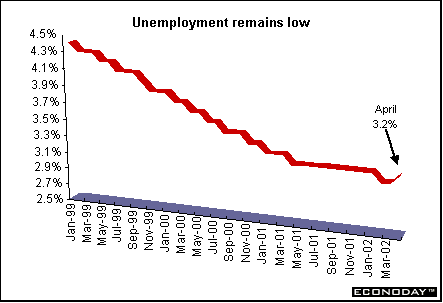 Average earnings rose 2.9 percent in the three months to March from the year earlier period. Despite March's rise, growth in earnings remains well below the 4.5 percent growth rate that the Bank of England sees as compatible with non-inflationary growth. 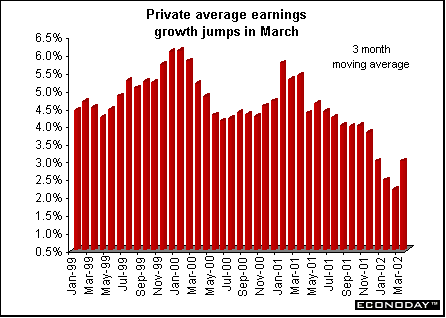 Asia Japan — Bankruptcies rose for the eighth straight month. April corporate failures climbed 2.2 percent from a year ago, leaving ¥1.1 trillion ($8.6 billion) in debts according to credit research firm Tokyo Shoko. This year, 19 publicly traded companies filled for bankruptcy, breaking the previous annual record of 14, set last year. Overall, 6,569 companies failed in the first four months of 2002, or an average of 55 a day, just shy of 1984's pace when a record 20,841 companies failed. Bankruptcies at retailers fell 16 percent to 157 from a year ago. The construction industry, which employs about one in 10 Japanese workers, had 476 bankruptcies, a 1.9 percent decline. The number of manufacturing failures rose 7.8 percent from a year ago to 331. The current account surplus expanded for the sixth straight month in March, rising 51.8 percent from a year earlier. The surplus in the current account, which is the broadest measure of trade with the rest of the world, stood at ¥2.203 trillion. For the full fiscal year ending in March 2002, the surplus fell 3.7 percent, the third straight year it has declined. Japan's current account surplus has been under pressure as more companies have shifted manufacturing to cheaper sites abroad and as domestically produced goods have become less competitive. The surplus has also suffered as the global economy has slowed following the burst of the information technology bubble. The current account measures trade in goods, services, tourism and investment. It is calculated by determining the difference between income from foreign sources against payments on foreign obligations, and excludes net capital investment. April Tokyo department store sales fell 4.8 percent on the year. The fall marked the fifth straight month that sales have dropped, showing that consumer spending continues to founder. Americas Canada — March manufacturers’ shipments slipped 0.7 percent after rising for the two prior months. Decreases in motor vehicle and chemical products manufacturing partly offset a surge in the petroleum and coal products industry. Excluding the impact of motor vehicle, parts and accessories industries, total shipments edged up 0.1 percent. Partly offsetting March's decline, shipments of petroleum and coal products soared 14.5 percent, boosted by a 7.3 percent rise in prices during the month. Fourteen of 21 industries, representing 70 percent of total shipments, reported lower shipments. For the second straight month, manufacturers reported higher unfilled orders. Orders climbed 1.4 percent due to increases in the computer and primary metal industries. New orders fell 0.3 percent, following strong gains in January and February. March merchandise trade surplus fell by C$376 million to C$4.4 billion, the lowest level since October 2001. The 7.9 percent drop was a result of falling exports to all of Canada's principal trading partners except Japan and the other OECD countries. Exports fell by 2.0 percent and imports fell 1.0 percent. The trade surplus with the United States fell by C$229 million to C$7.4 billion. Canadian companies’ exports to the United States were down 0.6 percent while imports rose 0.2 percent. 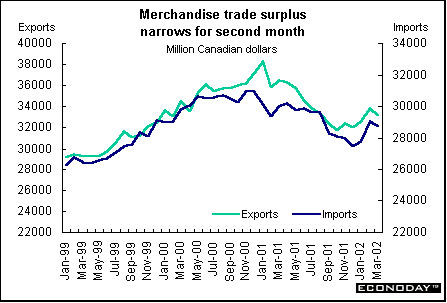 | ![[Back To Archive]](../../../images/backtoarchive.gif)